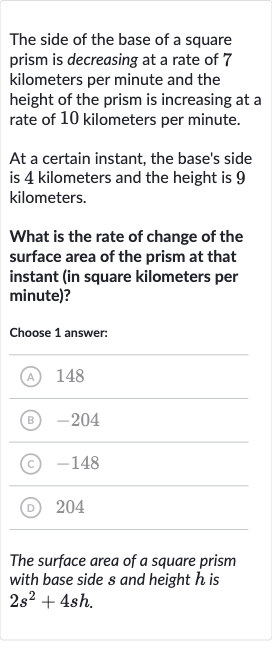AI tutor
Welcome to Bytelearn!
Let’s check out your problem:

The side of the base of a square prism is decreasing at a rate of kilometers per minute and the height of the prism is increasing at a rate of kilometers per minute.At a certain instant, the base's side is kilometers and the height is kilometers.What is the rate of change of the surface area of the prism at that instant (in square kilometers per minute)?Choose answer:(A) (B) (C) (D) The surface area of a square prism with base side and height is .
Full solution
Q. The side of the base of a square prism is decreasing at a rate of kilometers per minute and the height of the prism is increasing at a rate of kilometers per minute.At a certain instant, the base's side is kilometers and the height is kilometers.What is the rate of change of the surface area of the prism at that instant (in square kilometers per minute)?Choose answer:(A) (B) (C) (D) The surface area of a square prism with base side and height is .
- Formula Explanation: The surface area (SA) of a square prism is given by the formula , where is the side of the base and is the height.
- Chain Rule Application: We need to find the rate of change of the surface area with respect to time, which is .
- Derivative Calculations: To find , we'll use the chain rule from calculus: .
- Rate of Change Calculation: First, we calculate , since the derivative of with respect to is and the derivative of with respect to is .
- Substitution of Values: Next, we calculate , since the derivative of with respect to is and the derivative of with respect to is .
- Final Calculation: Now we plug in the values for and , which are km/min and km/min, respectively.
- Final Calculation: Now we plug in the values for and , which are and , respectively.We also plug in the values for and at the given instant, which are and , respectively.
- Final Calculation: Now we plug in the values for and , which are and , respectively. We also plug in the values for and at the given instant, which are and , respectively. So, .
- Final Calculation: Now we plug in the values for and , which are and , respectively. We also plug in the values for and at the given instant, which are and , respectively. So, . Substitute and into the equation: .
- Final Calculation: Now we plug in the values for and , which are and , respectively. We also plug in the values for and at the given instant, which are and , respectively. So, . Substitute and into the equation: . Simplify the equation: .
- Final Calculation: Now we plug in the values for and , which are and , respectively. We also plug in the values for and at the given instant, which are and , respectively. So, . Substitute and into the equation: . Simplify the equation: . Calculate the values: .
- Final Calculation: Now we plug in the values for and , which are and , respectively. We also plug in the values for and at the given instant, which are and , respectively. So, . Substitute and into the equation: . Simplify the equation: . Calculate the values: . .
- Final Calculation: Now we plug in the values for and , which are and , respectively. We also plug in the values for and at the given instant, which are and , respectively. So, . Substitute and into the equation: . Simplify the equation: . Calculate the values: . . Finally, square kilometers per minute.
